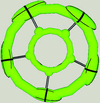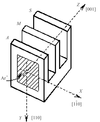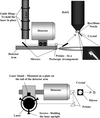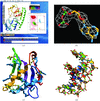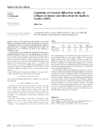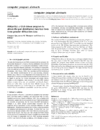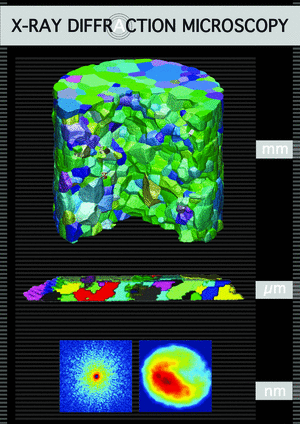issue contents
August 2004 issue

Cover illustration: Volumetric visualization of electron density surrounding a histidine residue, allowing for direct observation of discrete disorder; generated with POVScript+ and rendered with POVRay. Courtesy of T. D. Fenn, D. Ringe & G. A. Petsko [J. Appl. Cryst. (2003), 36, 944-947].
research papers
Open  access
access
 access
accessThe total radiation dose that can be absorbed by a crystal before the diffraction pattern is destroyed is finite. A program, RADDOSE, is presented that calculates the irradiation time by which the theoretical dose limit is reached for a given crystal and X-ray energy.
A detailed consideration of particle size distributions in nanostructured powders determined by small-angle scattering is presented including a direct measure of the width of the particle size distribution and the moments of the distribution for spherical particles. Comparison is made with TEM and gas adsorption data from crystalline pyrolytic powders, as well as with the available techniques for the determination of particle size distribution in scattering.
Open  access
access
 access
accessAn analysis of simulated framework structure, based on the rigid-unit model and providing a novel way of extracting information from reverse Monte Carlo simulations, is developed. A program called GASP has been developed to perform this analysis and this program is freely available to researchers.
Open  access
access
 access
accessIn cases where there is massive librational disorder, smearing the atomic density out over a simple geometric shape provides a more realistic approximation to the true electron density than using a model consisting of multiply disordered partial atoms. This implementation enables simple geometric shapes to coexist with localized atoms.
Open  access
access
 access
accessThis paper reports unexpected results obtained from independent measurements of a selection of recently grown lead titanate crystals, in which the birefringence is some four times greater than hitherto believed. This has important consequences for the use of birefringence measurements as a means of studying phase transitions in crystals.
Open  access
access
 access
accessLysozyme has been used for an investigation into locating the sulfur anomalous scatterers using rotating anode or synchrotron radiation data recorded at room temperature, thus spanning wavelengths from 0.71 to 2 Å. It was possible to locate the sulfur atoms from a lysozyme crystal at room temperature using softer synchrotron X-rays, the experience thus gained benefiting the case of apocrustacyanin A1.
A new high-resolution low-noise X-ray diffractometer that requires minimal sample alignment is described. Examples include the analysis of semiconductors in microdiffraction mode, and the study of bent and imperfect samples, and the results are compared with those obtained with other diffractometers.
Oriented lamellar nanocomposites formed of alternating organic and inorganic layers were prepared by evaporation-induced self-assembly and studied by small-angle X-ray scattering in symmetrical and asymmetrical reflection. A quantitative fit of the experimental data leads to a comprehensive characterization of the lamellar two-phase system in terms of the average thicknesses of the lamellae, the average period and the corresponding variances, using both the stacking model and the lattice model.
Lateral deformations caused by argon ions with energy 180 keV implanted in silicon are investigated by the X-ray interferometric method. By means of interferometric topograms, relative deformations and integral stresses are determined depending on radiation dose.
Download citation


Download citation


Elastic interaction between molecules becomes visible by the change of bond length with the concentration x in an FexZn1−x mixed crystal.
Open  access
access
 access
accessThis paper describes a new approach for estimating the depth capabilities of neutron and synchrotron diffraction instruments for strain measurement. The following paper (part II) uses the framework developed here to evaluate the conditions under which neutron and synchrotron instruments can provide acceptable strain measurements, and delineates the conditions under which the two types of instruments are most suited.
Open  access
access
 access
accessThe companion paper (part I) described an approach for calculating the practical penetration length capability of neutron and synchrotron diffraction instruments for strain measurement. The present paper (part II) uses the framework developed in part I to evaluate the conditions under which neutron and synchrotron instruments can provide acceptable strain measurements, and delineates the conditions over which each is most suited.
A microstructure model for the description of scattering phenomena in nanocrystalline materials is proposed and verified experimentally by a combination of X-ray diffraction and transmission electron microscopy with high resolution. It is shown that nanocrystalline domains can be partially coherent to X-rays at low diffraction angles; the microstructure parameters governing the coherence are the size and the preferred orientation of crystallites.
Mathematical aspects of the close relationship between the Rietveld method and the two-stage Pawley and correlated integrated intensities refinement of powder diffraction data are discussed.
The whole-powder-pattern modelling procedure is modified to allow a fast refinement of the grain size distribution for a given crystallite shape, without using any a priori chosen analytical expression. The proposed algorithm is tested both on simulated and on real data for nanocrystalline ceria.
Open  access
access
 access
accessMultivariate statistical methods are used to analyse a set of 27 powder diffraction patterns of alumina collected at different laboratories on different instruments using the PolySNAP software.
A triangular smoothing function is used to approximate the scattering length density (or electron density) gradient between two phases and an analytical expression to determine the transition-layer thickness is described using the modified Porod law.
short communications
Open  access
access
 access
accessUntil now the study of structures under irradiation has been carried out with a `point and fire' approach. This paper presents a device that simplifies laser alignment and makes possible the collection of a full sphere of data without risking obstruction of the incident or scattered X-rays, or the laser beam.
computer programs
MolViewX is a molecular visualization tool written for the Macintosh OS X operating system with a graphical user interface designed for occasional or novice users, but which can also be used to create high-quality images rapidly for publication.
Open  access
access
 access
accessPolySNAP is a computer program for the analysis of powder diffraction patterns produced in a high-throughput environment. A correlation matrix is generated by matching full-profile powder patterns; this is used by cluster analysis, multivariate data analysis and data visualization routines to classify the patterns automatically into groups and thus identify polymorphs, mixtures and salts.
Open  access
access
 access
accessSNAP-1D is a computer program with a novel approach to the qualitative and quantitative analysis of powder diffraction data using the full measured data points. Both non-parametric statistical tests based on Spearman's correlation coefficient and the Kolmogorov–Smirnov test, and more conventional correlations are used to match patterns, and by the use of singular value decomposition techniques, the method can be extended to the quantitative analysis of mixtures.
CIF applications
Open  access
access
 access
accessThis paper describes the program CIF2CRY for the conversion of structural CIF data into a CRYSTALS input format.
laboratory notes
The construction and use of a vacuum chamber suitable for conventional X-ray diffraction has revealed the effects of the ambient environment, including moisture, on the bulk structure of very thin polymer films.
A design for a modular device installed in a laboratory furnace is presented. The setup allows regulation and simultaneous crystallization tests of several substances, with the purpose of obtaining crystals.
letters to the editor
Free 

Open  access
access
 access
accessResponse to comments on Skakle & Aspden [J. Appl. Cryst. (2002), 35, 506–508].
computer program abstracts
PDFgetX2, a GUI-driven program to obtain the pair distribution function from X-ray powder diffraction data, is described.
A user-friendly Microsoft Windows-based structure visualization and animation program is presented.


 journal menu
journal menu











